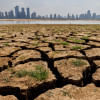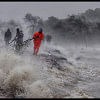Politics of climate change, sinking Bangladesh and floating houses

Climate change is real and it is here to stay. There is no turning around because we have already gone too far. It will only get worse from here. Climate change is, therefore, an existential threat for our children and grandchildren for whom time is running out fast.
Apparently, it isn't a threat for those who abdicated leadership of a warmer world and yet formulate environment-damaging energy policies from the luxury of their cooler world—air-conditioned homes and offices. If they cared even a bit about their progeny, they wouldn't be flying in ozone-layer-depleting private planes or riding fossil-fuel-guzzling stretched limos and SUVs.
A few world leaders led by Donald Trump believe that carbon dioxide makes the earth greener instead of creating climate crisis. Consequently, Trump deleted references to "climate change" from government websites, fired scientists from advisory boards and the Environmental Protection Agency. He seized on the uncertainty in climate models to reverse greenhouse gas emission regulations of the Obama administration and withdrew the United States from the 2016 Paris Agreement on curbing global warming. He even nonsensically blamed this year's out-of-control California fires on environmental laws. Other climate change deniers are his bagful of deplorables, the well-paid operatives of organisations that take contributions from fossil fuel corporations and a colourful cast of self-styled "experts" who have made a living out of rejecting the scientific evidence of climate change.
They are perhaps not aware that one of the most alarming but reliable projections for global warming has been made by researchers at the prestigious Carnegie Institution of Science in Stanford in California. The results of their research, based on a decade's worth of satellite observations concerning the net balance between the amount of energy entering and leaving the atmosphere, have been published in the December 2017 issue of the high impact, peer-reviewed journal Nature. They concluded that if large emissions of greenhouse gases continue unabated throughout the century, worldwide temperatures could rise nearly five degrees Celsius between 2081 and 2100.
It is an undeniable fact that episodes of raging wildfires, high-category hurricanes, ferocious cyclones, floods of biblical proportions, deadly mudslides, severe droughts, bone-chilling Arctic blasts followed by lethal heatwaves and the melting of Arctic ice at a rate never before seen are effects of a sub-one degree rise in global temperature since 1880. Heaven only knows what will happen if we, as agreed upon by the 2016 Paris Agreement's stakeholders, take the free pass of heating up our planet by two degrees before the end of this century.
Even a two-degree rise in global temperature would most likely set the stage for the greenhouse effect to spin out of control, eventually triggering a runaway greenhouse effect whose impacts would be cataclysmic, to say the least. Nevertheless, scientists at the Intergovernmental Panel on Climate Change believe that there is virtually no chance of a runaway greenhouse effect being induced by human activities, despite the fact that greenhouse gas emissions are still moving in the wrong direction.
What triggers a runaway greenhouse effect? The increase of atmospheric carbon dioxide and water vapour, two of the dominant greenhouse gases, would raise the global temperature which, in turn, would cause more water from the oceans to evaporate and carbon dioxide stored in the soil and oceans to bake out. This would be in addition to the carbon dioxide produced by burning fossil fuels. The positive feedback of continued emission of these greenhouse gases would ultimately snare our planet into a vicious cycle of a runaway greenhouse effect, which was responsible for raising the surface temperature of Venus to a blistering 480 degrees Celsius—hot enough to melt lead.
One of the countries that is already paying a hefty price for the climate sins of industrial nations is Bangladesh. It is predicted that the two-degree boost in temperature and the subsequent rise of sea levels would sink the coastal areas of Bangladesh, thereby resulting in an unprecedented human tragedy. Already, the intruding sea has contaminated groundwater which supplies drinking water for coastal regions and degraded farmlands, rendering them less fertile and at places completely barren.
Although engineering adaptations to climate change have been successful in other countries, such as the dikes constructed in the Netherlands, they won't work in Bangladesh because the soils are sandy and constantly shifting. Thus, if the country does not want to see millions of her climate refugees migrating inland and ending up in decrepit slums, then the government should take a serious look at the "Dream House"—a flood-resistant floating house—built by a team of BRAC University students.
The concept of floating houses and floating villages is not new. There are many such villages in the world. They are communities with houses and other amenities of a town built on top of large raft-like structures or on stilts, as in the Tonlé Sap Lake in Siem Reap in Cambodia.
Floating houses in Bangladesh's coastal areas could save the lives and livelihoods of millions from the catastrophic effects of anthropogenic climate change. Bangladeshi farmers have already developed techniques for building floating farms, known as "dhaps," with duck coops, fish enclosures and vegetable gardens anchored by ropes to the riverbanks where the water rises at least three metres during the monsoon season.
The arduous life of the people living in the floating dwellings that would gently rock and roll with the ebb and flow of the Bay of Bengal would not only be a paragon of adapting to climate change but also a modern-day example of Darwin's "survival of the fittest."
Quamrul Haider is a Professor of Physics at Fordham University, New York.










Comments